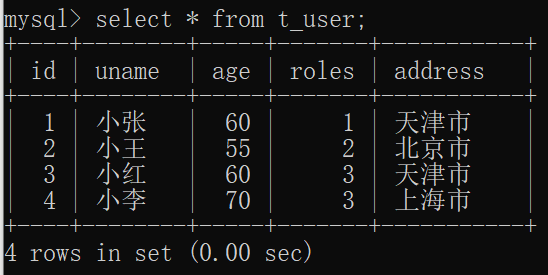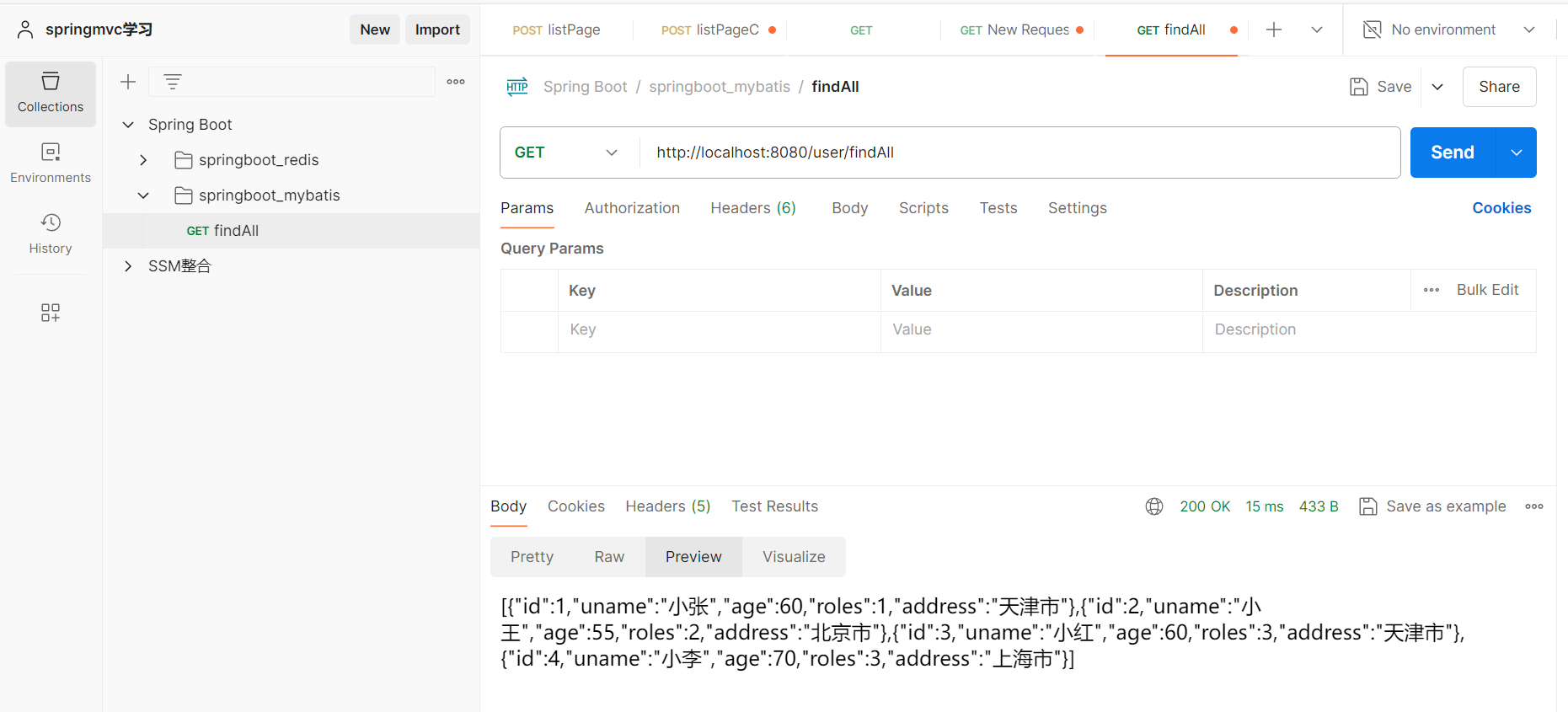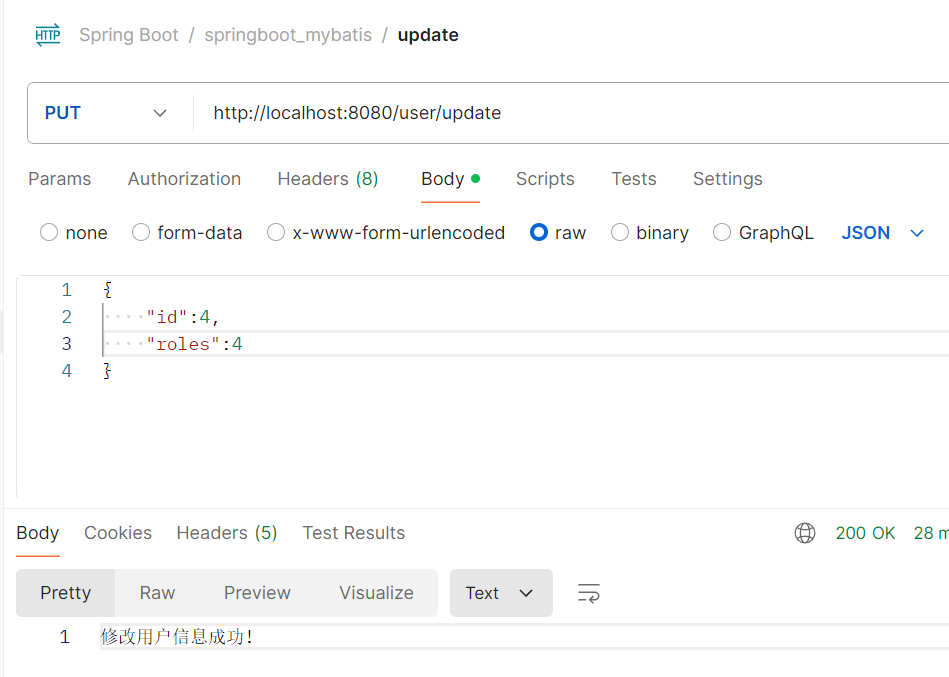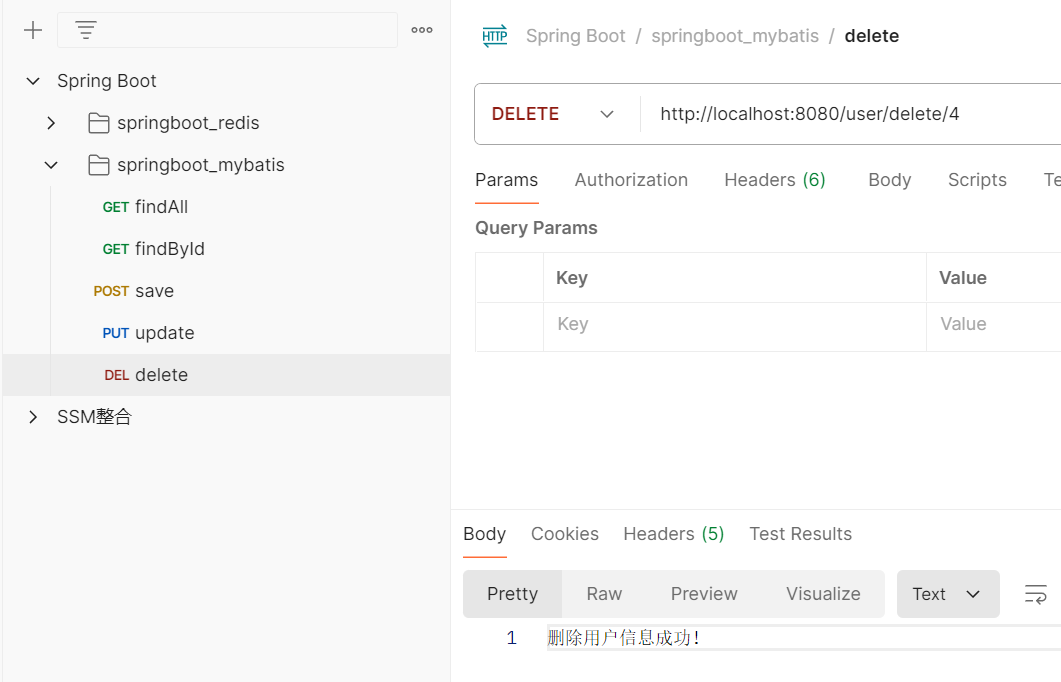目录
9、SpringBootMyBatisApplication启动类
学习该项目时的一点心得:
在学习SpringBoot整合MyBatis时,网上的资料实在太多了,学得有点混乱。后来找到了一本书《SpringBoot企业级应用开发实战教程》张磊、宋洁、张建军著,里面的内容简洁明了,容易理解。然后跟着书敲出这个项目,以这个小项目为基点,再去对比其他的SpringBoot整合MyBatis的项目,有不同的地方就查资料,为什么不一样,尽力让项目变得更完美,在此过程中,也不断地确定了SpringBoot整合MyBatis时的核心要点是什么。
MyBatis
- MyBatis是一个支持普通SQL查询,存储过程和高级映射的优秀持久层框架
- MyBatis可以使用简单的XML或注解用于配置和原始映射,将接口和Java的POJO(Plain Old Java Objects,普通的传统的Java对象)映射成数据库中的记录
项目总结
工作流程
创建一个Spring Boot项目,并在pom.xml中添加必要的依赖
在application.properties文件中配置数据库的连接信息和MyBatis的相关配置信息。
创建一个实体类User,该实体类对应数据库中的t_user表的结构。
然后使用MyBatis的注解或者XML配置文件来定义数据库操作的接口和方法。
创建一个UserMapper接口,用于定义数据库操作的方法。在接口中定义了各种增删改查的方法。
创建一个UserMapper.xml文件,该文件对应UserMapper接口中定义的方法。在该文件中配置每个方法对应的SQL语句。
在 UserController 控制器中注入对应的数据库操作接口,并调用接口中的方法来实现相关的业务逻辑。
创建SpringBootMyBatisApplication类作为项目的启动类,
并在该类上添加@SpringBootApplication注解,表示这是一个Spring Boot项目。
添加@MapperScan,扫描接口类
整个过程中,Spring Boot会根据配置文件和注解来自动装配相应的Bean,并管理整个项目的生命周期。
1、创建SQL表
- 表名和列名应使用反引号(`)而不是单引号(')
CREATE DATABASE userdb;USE userdb;DROP table IF EXISTS t_user;CREATE TABLE `t_user`(
`id` INT(11) NOT NULL AUTO_INCREMENT,
`uname` VARCHAR(20) NOT NULL,
`age` TINYINT(4) NOT NULL,
`roles` INT(11) NOT NULL,
`address` VARCHAR(255),
PRIMARY KEY (`id`)
);
INSERT INTO `t_user`(`id`,`uname`,`age`,`roles`,`address`)
VALUES (1,'小张',60,1,'天津市'),(2,'小王',55,2,'北京市'),(3,'小红',60,3,'天津市'),(4,'小李',70,3,'上海市');

打开MySQL,保持运行,不要关闭黑窗

2、新建一个SpringBoot项目
挑选技术支持:
- Lombok
- SpringWeb
- MySQL Driver
- MyBatis Framework

项目结构:

3、pom.xml添加依赖
- 注意版本号,我是从3.x降到2.x才跑通
<?xml version="1.0" encoding="UTF-8"?>
<project xmlns="http://maven.apache.org/POM/4.0.0" xmlns:xsi="http://www.w3.org/2001/XMLSchema-instance"
xsi:schemaLocation="http://maven.apache.org/POM/4.0.0 https://maven.apache.org/xsd/maven-4.0.0.xsd">
<modelVersion>4.0.0</modelVersion>
<parent>
<groupId>org.springframework.boot</groupId>
<artifactId>spring-boot-starter-parent</artifactId>
<version>2.3.12.RELEASE</version>
<relativePath/> <!-- lookup parent from repository -->
</parent>
<groupId>com.study</groupId>
<artifactId>springboot_mybatis</artifactId>
<version>0.0.1-SNAPSHOT</version>
<name>springboot_mybatis</name>
<description>Demo project for Spring Boot</description>
<properties>
<java.version>8</java.version>
</properties>
<dependencies>
<dependency>
<groupId>org.springframework.boot</groupId>
<artifactId>spring-boot-starter-web</artifactId>
</dependency>
<!--添加MyBatis依赖-->
<dependency>
<groupId>org.mybatis.spring.boot</groupId>
<artifactId>mybatis-spring-boot-starter</artifactId>
<version>2.2.2</version>
</dependency>
<!--添加MySQL依赖-->
<dependency>
<groupId>mysql</groupId>
<artifactId>mysql-connector-java</artifactId>
</dependency>
<dependency>
<groupId>org.projectlombok</groupId>
<artifactId>lombok</artifactId>
<optional>true</optional>
</dependency>
<dependency>
<groupId>org.springframework.boot</groupId>
<artifactId>spring-boot-starter-test</artifactId>
<scope>test</scope>
</dependency>
<dependency>
<groupId>org.mybatis.spring.boot</groupId>
<artifactId>mybatis-spring-boot-starter-test</artifactId>
<version>2.2.2</version>
<scope>test</scope>
</dependency>
</dependencies>
<build>
<plugins>
<plugin>
<groupId>org.springframework.boot</groupId>
<artifactId>spring-boot-maven-plugin</artifactId>
<configuration>
<excludes>
<exclude>
<groupId>org.projectlombok</groupId>
<artifactId>lombok</artifactId>
</exclude>
</excludes>
</configuration>
</plugin>
</plugins>
</build>
</project>
4、application.properties配置文件
# userdb是使用的数据库名字
spring.datasource.url=jdbc:mysql://localhost:3306/userdb?serverTimezone=UTC
spring.datasource.username=root
spring.datasource.password=admin
spring.datasource.driver-class-name=com.mysql.cj.jdbc.Driver
# 添加mapper-locations路径,扫描*Mapper.xml文件,一般不用改,*Mapper是指命名以Mapper结尾的XML文件
mybatis.mapper-locations=classpath*:mapper/*Mapper.xml
5、User实体类
package com.study.springboot_mybatis.pojo;
import lombok.Data;
import java.io.Serializable;
@Data //添加lombok依赖,自动生成getter和setter
public class User implements Serializable {
private Integer id;
private String uname;
private int age;
private int roles;
private String address;
}
6、UserMapper接口
package com.study.springboot_mybatis.mapper;
import com.study.springboot_mybatis.pojo.User;
import org.springframework.stereotype.Repository;
import java.util.List;
//通过在类上添加@Repository注解,Spring可以自动创建该类的实例,并将其注入到其他需要访问数据库或持久化的组件中。
@Repository
public interface UserMapper {
List<User> selectUserList();
User findById(int id);
int save(User user);
int update(User user);
int delete(Integer id);
}
7、UserMapper.xml映射文件
- 接口类名称要和Mapper映射文件的名称一致
- 接口中的方法要和映射文件id值名称一致
<?xml version="1.0" encoding="UTF-8"?>
<!DOCTYPE mapper
PUBLIC "-//mybatis.org//DTD Mapper 3.0//EN"
"http://mybatis.org/dtd/mybatis-3-mapper.dtd" >
<mapper namespace="com.study.springboot_mybatis.mapper.UserMapper">
<resultMap id="BaseResultMap" type="com.study.springboot_mybatis.pojo.User">
<!--
1.column 指定表字段名或其别名
2.property 指定 javaBean 的属性名
3.jdbcType 指定表字段类型
4.javaType 指定类属性的java类型
-->
<result column="id" jdbcType="INTEGER" property="id" javaType="java.lang.Integer"/>
<result column="uname" jdbcType="VARCHAR" property="uname" javaType="java.lang.String"/>
<result column="age" jdbcType="INTEGER" property="age" javaType="java.lang.Integer"/>
<result column="roles" jdbcType="INTEGER" property="id" javaType="java.lang.Integer"/>
<result column="address" jdbcType="VARCHAR" property="address" javaType="java.lang.String"/>
</resultMap>
<!--useGeneratedKeys:是够获取自动增长的主键值。true表示获取
keyProperty :指定将获取到的主键值封装到哪儿个属性里-->
<insert id="save" parameterType="com.study.springboot_mybatis.pojo.User" useGeneratedKeys="true" keyProperty="id">
insert into t_user
<trim prefix="(" suffix=")" suffixOverrides=",">
<if test="id != null">
id,
</if>
<if test="uname != null">
uname,
</if>
<if test="age != null">
age,
</if>
<if test="roles != null">
roles,
</if>
<if test="address != null">
address,
</if>
</trim>
<trim prefix="values (" suffix=")" suffixOverrides=",">
<if test="id != null">
<!--#{id} 是 MyBatis 的参数占位符,表示将会传入的参数中的 id 字段的值替换到此处。-->
#{id,jdbcType=INTEGER},
</if>
<if test="uname != null">
#{uname,jdbcType=VARCHAR},
</if>
<if test="age != null">
#{age,jdbcType=INTEGER},
</if>
<if test="roles != null">
#{roles,jdbcType=INTEGER},
</if>
<if test="address != null">
#{address,jdbcType=VARCHAR},
</if>
</trim>
</insert>
<update id="update" parameterType="com.study.springboot_mybatis.pojo.User">
update t_user
<!--set 标签可以用于动态包含需要更新的列,忽略其它不更新的列
下面是ID不变,其他信息动态更新,即通过ID找到要修改的用户-->
<set>
<!--<trim> 标签用于修剪 SQL 语句中不必要的部分。
这里设置了 prefix、suffix 和 suffixOverrides 属性为空,
表示不添加任何前缀和后缀,并且去除 SQL 语句末尾可能多余的逗号。
根据条件使用了 <if> 标签来判断是否更新相应的列-->
<trim prefix="" suffix="" suffixOverrides=",">
<!--使用了 <if> 标签来判断是否更新相应的列。如果条件为真,则添加对应的更新语句-->
<if test="uname != null">
uname = #{uname,jdbcType=VARCHAR},
</if>
<if test="age != null">
age = #{age},
</if>
<if test="roles != null">
roles = #{roles,jdbcType=INTEGER},
</if>
<if test="address != null">
address = #{address,jdbcType=VARCHAR},
</if>
</trim>
</set>
where id = #{id,jdbcType=BIGINT}
</update>
<delete id="delete" parameterType="java.lang.Integer">
delete
from t_user
where id = #{id,jdbcType=INTEGER}
</delete>
<!--查询全部记录-->
<select id="selectUserList" resultType="com.study.springboot_mybatis.pojo.User">
select * from t_user;
</select>
<select id="findById" resultType="com.study.springboot_mybatis.pojo.User">
select * from t_user where id = #{id};
</select>
</mapper>
8、UserController控制器
- UserController是一个基于Spring Boot的RESTful风格的控制器类,用于处理用户相关的HTTP请求
ResponseEntity则是 Spring Framework 中用于表示 HTTP 响应的一个类,它包含了响应的状态码、头部信息和响应体等内容。在 Spring MVC 或 Spring Boot 中,我们通常会将处理方法的返回值包装为ResponseEntity对象,以便更加灵活地设置 HTTP 响应的各种属性。
package com.study.springboot_mybatis.controller;
import com.study.springboot_mybatis.mapper.UserMapper;
import com.study.springboot_mybatis.pojo.User;
import org.springframework.beans.factory.annotation.Autowired;
import org.springframework.http.HttpStatus;
import org.springframework.http.ResponseEntity;
import org.springframework.stereotype.Repository;
import org.springframework.web.bind.annotation.*;
import java.util.List;
@RestController
@RequestMapping("/user")
public class UserController {
@Autowired
UserMapper userMapper;
@GetMapping("/findAll")
ResponseEntity<List<User>> findAllUser(){
List<User> list = userMapper.selectUserList();
return ResponseEntity.status(HttpStatus.OK).body(list);
}
@GetMapping("/findById/{id}")
ResponseEntity<User> findById(@PathVariable("id") Integer id){
if(id==null || id<1){
return ResponseEntity.status(HttpStatus.BAD_REQUEST).build();
}
User user = userMapper.findById(id);
if(user == null){
return ResponseEntity.status(HttpStatus.NOT_FOUND).build();
}
return ResponseEntity.status(HttpStatus.OK).body(user);
}
@PostMapping("/save")
public ResponseEntity<String> save(@RequestBody User user){
if(user==null){
return ResponseEntity.status(HttpStatus.BAD_REQUEST).build();
}
Integer count = userMapper.save(user);
if(count == null || count == 0){
return ResponseEntity.status(HttpStatus.BAD_REQUEST).build();
}
if(count > 0){
return ResponseEntity.status(HttpStatus.CREATED).body("添加新用户信息成功!");
}else{
return ResponseEntity.status(HttpStatus.BAD_REQUEST).body("添加新用户信息失败!");
}
}
@PutMapping("/update")
public ResponseEntity<String> update(@RequestBody User user){
if(user==null){
return ResponseEntity.status(HttpStatus.BAD_REQUEST).build();
}
Integer count = userMapper.update(user);
if(count == null || count == 0){
return ResponseEntity.status(HttpStatus.BAD_REQUEST).build();
}
if(count > 0){
return ResponseEntity.status(HttpStatus.OK).body("修改用户信息成功!");
}else{
return ResponseEntity.status(HttpStatus.BAD_REQUEST).body("修改用户信息失败!");
}
}
@DeleteMapping("/delete/{id}")
ResponseEntity<String> delete(@PathVariable("id") Integer id){
if(id == null || id < 1){
return ResponseEntity.status(HttpStatus.BAD_REQUEST).build();
}
Integer count = userMapper.delete(id);
if(count == null || count == 0){
return ResponseEntity.status(HttpStatus.NOT_FOUND).build();
}
if(count > 0){
return ResponseEntity.status(HttpStatus.OK).body("删除用户信息成功!");
}else{
return ResponseEntity.status(HttpStatus.BAD_REQUEST).body("删除用户信息失败!");
}
}
}
9、SpringBootMyBatisApplication启动类
package com.study.springboot_mybatis;
import org.mybatis.spring.annotation.MapperScan;
import org.springframework.boot.SpringApplication;
import org.springframework.boot.autoconfigure.SpringBootApplication;
@SpringBootApplication
//扫描basePackages下的mapper接口,并创建代理对象
@MapperScan(basePackages = {"com.study.springboot_mybatis.mapper"})
public class SpringbootMybatisApplication {
public static void main(String[] args) {
SpringApplication.run(SpringbootMybatisApplication.class, args);
}
}
10、使用Postman进行测试
- 根据UserController类中的方法逐个进行测试
1、findAll():查找全部

2、findById:通过ID进行查找

3、save:添加新用户
 4、update:修改用户信息
4、update:修改用户信息
通过ID指定用户,修改任一信息,下列是修改 id=4 的用户的 roles 为4

5、delete:删除用户

























 1938
1938











 被折叠的 条评论
为什么被折叠?
被折叠的 条评论
为什么被折叠?










